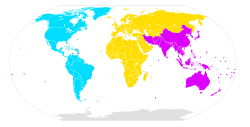5-centimeter band
The 5 centimeter or 5 GHz band is a portion of the SHF (microwave) radio spectrum internationally allocated to amateur radio and amateur satellite use on a secondary basis. In ITU regions 1 and 3, the amateur radio band is between 5,650 MHz and 5,850 MHz. In ITU region 2, the amateur radio band is between 5,650 MHz and 5,925 MHz. The amateur satellite service is allocated 5,830 to 5,850 MHz, for down-links only on a secondary basis, and it is also allocated 5,650 to 5,670 MHz, for up-links only on a non-interference basis to other users (ITU footnote 5.282). Amateur stations must accept harmful interference from ISM users operating in the band.[1] The band is within the IEEE C Band spectrum.
The 5 cm band in the United States overlaps part of the U-NII band and all of 5 GHz ISM band. Both overlapping bands are available for license-free applications such as WiFi or Part 15 devices.[2]
5 cm is one of the primary bands for high-speed multimedia radio, as most U-NII and Part 15 equipment may be re-tuned to amateur frequencies.
List of notable frequencies

- 5,668.2 MHz Region 1 Calling Frequency 1[3]
- 5,760.1 MHz Region 2 Calling Frequency[4]
- 5,760.2 MHz Region 1 Calling Frequency 2[3]
- 5,800 MHz ISM band center frequency
See also
References
- ↑ "FCC Online Table of Frequency Allocations" (PDF). 47 C.F.R. Federal Communications Commission. August 13, 2015. Retrieved October 27, 2015.
- ↑ "Title 47 CFR Part 15 Subpart E".
- 1 2 "VHF Managers Handbook" (PDF). 7. International Amateur Radio Union Region 1. January 2015. pp. 45–46. Retrieved October 27, 2015.
- ↑ "IARU Region 2 Band Plan" (PDF). International Amateur Radio Union Region 2. September 27, 2013. p. 10. Retrieved October 27, 2015.
| International amateur radio frequency allocations | ||||
|---|---|---|---|---|
| Range | Band | ITU Region 1 | ITU Region 2 | ITU Region 3 |
| LF | 2200 m | 135.7 kHz – 137.8 kHz | ||
| MF | 600 m | 472 kHz – 479 kHz | ||
| 160 m | 1.810 MHz – 1.850 MHz | 1.800 MHz – 2.000 MHz | ||
| HF | 80 / 75 m | 3.500 MHz – 3.800 MHz | 3.500 MHz – 4.000 MHz | 3.500 MHz – 3.900 MHz |
| 60 m | 5.3515 MHz – 5.3665 MHz | |||
| 40 m | 7.000 MHz – 7.200 MHz | 7.000 MHz – 7.300 MHz | 7.000 MHz – 7.200 MHz | |
| 30 m2 | 10.100 MHz – 10.150 MHz | |||
| 20 m | 14.000 MHz – 14.350 MHz | |||
| 17 m2 | 18.068 MHz – 18.168 MHz | |||
| 15 m | 21.000 MHz – 21.450 MHz | |||
| 12 m2 | 24.890 MHz – 24.990 MHz | |||
| 10 m | 28.000 MHz – 29.700 MHz | |||
| VHF | 6 m | 50.000 MHz – 52.000 MHz1 | 50.000 MHz – 54.000 MHz | |
| 4 m1 | 70.000 MHz – 70.500 MHz | N/A | ||
| 2 m | 144.000 MHz – 146.000 MHz | 144.000 MHz – 148.000 MHz | ||
| 1.25 m | N/A | 220.000 MHz – 225.000 MHz | N/A | |
| UHF | 70 cm | 430.000 MHz – 440.000 MHz | 430.000 – 440.000 MHz (420.000 – 450.000 MHz)3 | |
| 33 cm | N/A | 902.000 MHz – 928.000 MHz | N/A | |
| 23 cm | 1.240 GHz – 1.300 GHz | |||
| 13 cm | 2.300 GHz – 2.450 GHz | |||
| SHF | 9 cm | 3.400 GHz – 3.475 GHz3 | 3.300 GHz – 3.500 GHz | |
| 5 cm | 5.650 GHz – 5.850 GHz | 5.650 GHz – 5.925 GHz | 5.650 GHz – 5.850 GHz | |
| 3 cm | 10.000 GHz – 10.500 GHz | |||
| 1.2 cm | 24.000 GHz – 24.250 GHz | |||
| EHF | 6 mm | 47.000 GHz – 47.200 GHz | ||
| 4 mm3 | 75.500 GHz1 – 81.500 GHz | 76.000 GHz – 81.500 GHz | ||
| 2.5 mm | 122.250 GHz – 123.000 GHz | |||
| 2 mm | 134.000 GHz – 141.000 GHz | |||
| 1 mm | 241.000 GHz – 250.000 GHz | |||
| THF | Sub-mm | Some administrations have authorized spectrum for amateur use in this region. | ||
|
1 This is not mentioned in the ITU's Table of Frequency Allocations, but individual administrations may make allocations under Article 4.4 of the ITU Radio Regulations. See the appropriate Wiki page for further information. | ||||
| See also: Radio spectrum · Electromagnetic spectrum | ||||